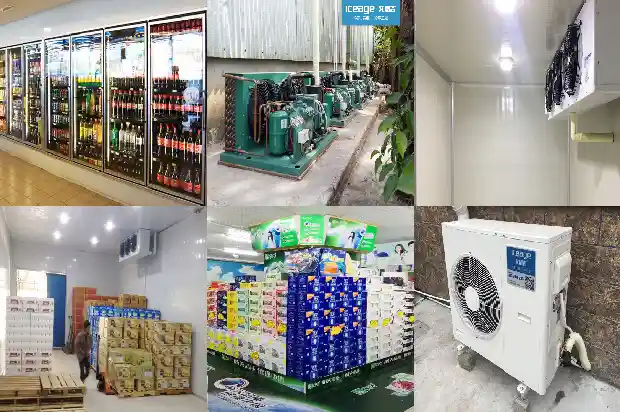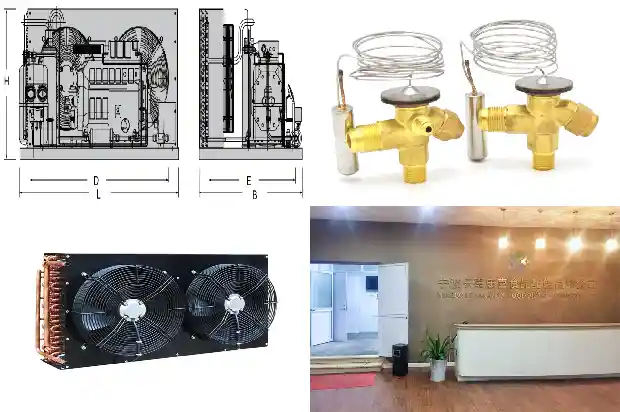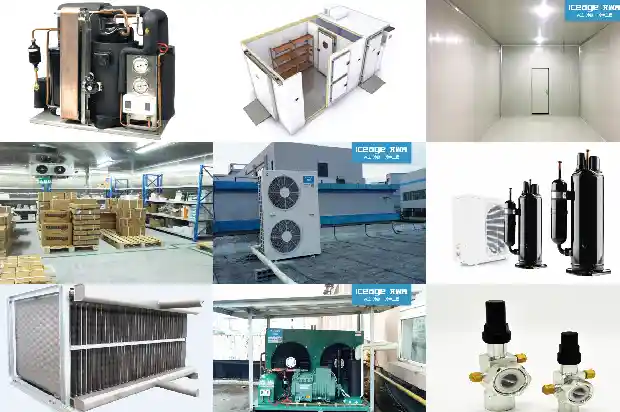Master the Compressor Replacement of the Multi-connected Unit System in Ten Steps
2025-03-04
Step 1: Cut off the Power Supply
After confirming that the compressor is damaged and needs to be replaced, first disconnect the power supply switch of the outdoor unit, disconnect the wiring at the power supply, and disconnect the power wiring of the outdoor unit and seal it with insulating tape.
Step 2: Clean the Components in the Electrical Box
When disassembling the compressor wiring, temperature sensing bulb, and electric heating, corresponding markings should be made to facilitate rewiring after replacement.
Step 3: Release the Refrigerant
When releasing the refrigerant of the system, the refrigerant should be released simultaneously from both the high-pressure side and the low-pressure side of the system. If the gas is released only from one side, the seal of the scroll plate will lead to incomplete refrigerant release. The speed of releasing the refrigerant should not be too fast, otherwise, a large amount of lubricating oil will be carried out of the system together with the refrigerant.
Step 4: Replacement of Fixed-frequency/Variable-frequency Compressor
Check the quality of the oil when disassembling the compressor. If the oil is clear and free of impurities, it can be considered that the oil quality in the system has not been contaminated. At the same time, when ensuring that there are no abnormalities in the valves and oil circuits of the unit, only the compressor can be replaced.
After confirming that the compressor is damaged and needs to be replaced, first disconnect the power supply switch of the outdoor unit, disconnect the wiring at the power supply, and disconnect the power wiring of the outdoor unit and seal it with insulating tape.
Step 2: Clean the Components in the Electrical Box
When disassembling the compressor wiring, temperature sensing bulb, and electric heating, corresponding markings should be made to facilitate rewiring after replacement.
Step 3: Release the Refrigerant
When releasing the refrigerant of the system, the refrigerant should be released simultaneously from both the high-pressure side and the low-pressure side of the system. If the gas is released only from one side, the seal of the scroll plate will lead to incomplete refrigerant release. The speed of releasing the refrigerant should not be too fast, otherwise, a large amount of lubricating oil will be carried out of the system together with the refrigerant.
Step 4: Replacement of Fixed-frequency/Variable-frequency Compressor
Check the quality of the oil when disassembling the compressor. If the oil is clear and free of impurities, it can be considered that the oil quality in the system has not been contaminated. At the same time, when ensuring that there are no abnormalities in the valves and oil circuits of the unit, only the compressor can be replaced.
- After removing the compressor, shake the compressor on a solid ground, and the shaking angle should be between 30° and 45° to ensure that the pollutants deposited at the bottom of the compressor can be poured out.
- Place the compressor at a position higher than the horizontal ground and pour oil from the compressor exhaust port. When pouring oil, use a beverage bottle or other transparent container to store the oil, and the collected oil volume should be more than 150ml. Note that the angle between the axial position of the compressor and the horizontal plane should not exceed 20°.

- Place the collected compressor lubricating oil in a bright place to observe whether there are impurities and color changes. At the same time, pay attention to the smell of the compressor lubricating oil. Normal lubricating oil has no obvious pungent smell.
If the variable-frequency compressor is damaged, or the oil quality in the fixed-frequency compressor is contaminated, the variable-frequency compressor needs to be removed, and even the oil separator and the gas-liquid separator need to be replaced.
Step 5: Confirm the System Components
When the oil quality of the system is contaminated, the condition of the components of the unit needs to be confirmed, including the oil separator, gas-liquid separator, and liquid receiver. - Remove the oil separator and confirm whether there are impurities and other substances.
- Remove the gas-liquid separator and confirm whether there are impurities and other substances.
Note: When the compressor is damaged and needs to be replaced, the gas-liquid separator must be replaced at the same time! Regardless of whether there are impurities or other abnormal conditions in the gas-liquid separator. - Remove the liquid receiver and confirm whether there are impurities and other substances.
Note: The amount of compressor lubricating oil poured out from the oil separator, gas-liquid separator, and liquid receiver should be collected, and relevant records should be made to facilitate the replenishment of lubricating oil to the system after replacing components such as the compressor and gas-liquid separator.
Step 6: Clean the System
After confirming the components that need to be replaced, it is necessary to confirm whether there are any abnormalities in the system pipeline. In addition to purging the main pipeline with nitrogen, the oil circuit system should also be focused on detecting and cleaning.
- Clean the pipeline of the oil equalizing pipe.
- Clean the pipeline of the oil return pipe.
Step 7: Check Before Replacement
Check whether the compressor models are consistent.
When handling the new compressor, it is necessary to pay attention that the compressor cannot be placed flat or upside down, and the inclination angle should be kept within ±30°. Also, pay attention to prevent the lubricating oil in the compressor from flowing out from the oil balance port.
Ensure that the sealing rubber blocks of the compressor, oil separator, gas-liquid separator, oil equalizer, and drier-filter are in good condition.
Step 8: Replace the Gas-liquid Separator
Place the gas-liquid separator in an appropriate position on the chassis, connect the inlet and outlet pipelines of the gas-liquid separator, and then connect the nitrogen interface to the connecting pipeline of the gas-liquid separator. The connection position of nitrogen can be selected according to the on-site situation. A bypass interface can be used or it can be directly connected to the inlet and outlet pipelines of the gas-liquid separator. When the pipeline is large, it can be connected with the help of adhesive tape, and it is necessary to ensure that nitrogen can flow smoothly through the gas-liquid separator.
Step 9: Replace the Liquid Receiver
After the liquid receiver is removed and inspected, if there are no impurities and foreign objects, it may not need to be replaced. Because the structure of the liquid receiver is just equivalent to a container tank and does not involve a complex structure, it generally does not need to be replaced. However, if there are impurities and foreign objects, it must be replaced because the pollutants inside the liquid receiver cannot be cleaned thoroughly.
Step 10: Replace the Compressor - If only the fixed-frequency compressor is replaced.
- If the variable-frequency compressor needs to be replaced.
- Specific matters needing attention when replacing the compressor:
- If the suction and discharge ports of the compressor are copper-plated steel pipes, solder containing at least 5% silver should be used. The welding gap should be between 0.1mm and 0.3mm to prevent welding blockage or false soldering. Do not overheat the pipe opening during the welding process.
- After the pipeline system is welded, use padding feet and bolts to fix the compressor to ensure the stability of the compressor during operation.
- It is prohibited for the compressor wiring to have a phase sequence error or for the variable-frequency and fixed-frequency connections to be mixed up.
Step 11: Replace the Oil Separator
Step 12: System Leak Detection - First, check each welding point. Observe whether the welding points are smooth and whether there are obvious welding holes and other abnormal situations.
- Pressurize the unit system with nitrogen to make the system pressure above 25kgf, close the large and small valves of the unit, and ensure that both the indoor and outdoor units are pressurized for more than 12 hours. If the pressure does not change, vacuuming can be started. Otherwise, leak detection should be carried out again until the leak point is detected.
Step 13: Add Refrigeration Oil - Connect the large and small valves of the unit and vacuum for more than 30 minutes. Connect the low-pressure measuring valve with a rubber tube, open the container containing the lubricating oil, pour the lubricating oil into the measuring cup to measure the appropriate additional amount. After adding the appropriate amount of lubricating oil, close the low-pressure measuring valve to ensure sealing.
Note: The refrigeration oil of the compressor plays a very important role in the normal operation of the compressor. It is necessary to ensure that the lubricating oil with the correct brand and qualified quality is filled according to the requirements of the equipment. At the same time, it is required to ensure that the additional amount is correct.
Step 15: Fill with Refrigerant
Fill with refrigerant according to the rated filling amount on the nameplate plus the additional amount of refrigerant calculated for the pipeline; if the unit is installed with multi-module connection and only the refrigerant of this outdoor unit was released before maintenance, after filling 80% of the rated filling amount on the nameplate of this outdoor unit, make corresponding adjustments through the startup debugging parameters.
Step 16: Connect the Electrical Components
Install the electrical box, make the correct wiring according to the previous markings and the circuit diagram behind the electrical box cover, connect the compressor wires and the corresponding electric heating belt.
Note: Be sure to carefully check according to the electrical wiring diagram and ensure that the wiring is correct!
Step 17: Startup and Debugging
Start up and debug the unit. Run the unit under the working conditions of full cooling operation, single cooling operation, full heating operation, and single heating operation respectively. Each working condition requires operation for more than 30 minutes, analyze the data, and adjust the unit system to ensure that all parameters are normal.
Related Articles
- Is the Compressor of the Cold Storage Unit Overheating? Find the Reasons Here!
- Common Fault Causes of Totally Enclosed Refrigeration Compressors
- Common Fault Causes and Replacement of Multi-connected Unit Compressors
- Why Does the Compressor Always Trigger the Overheat Protection?
- Reasons for Compressor Oil Deterioration and Oil - adding Operations
- Screw Compressor Units: Principles, Design and Selection - Essential Guide for Refrigeration Beginners
- Analysis of Causes for Compressor Liquid Hammer, Overheating and Pre - heating
- Oil Cooling Methods and Oil - changing Operation Procedures for Screw Compressors
- Have You Encountered the Three Common Problems of Refrigeration Compressors?
- What to Do if the Compressor of a Frozen and Refrigerated Display Cabinet Runs but the Refrigeration Effect Is Poor?
- What to Do if the Compressor of the 【Refrigerated and Frozen Display Cabinet】 Unit Fails to Start?
- Precautions for Using Rotary Refrigeration Compressors
- How to Resolve the Scuffing Issue of Cold Storage Compressors
- Composition and Common Faults of Screw Refrigeration Compressors
- What Are the Causes of Scroll Compressor Damage?
- Do You Know These Four Scenarios That Can Cause Compressor Failures?
- What Are the Reasons for Insufficient Air Output of Screw Air Compressors?
- How to Solve the Problem of Frequent Shutdown and Startup of Cold Storage Compressors?
